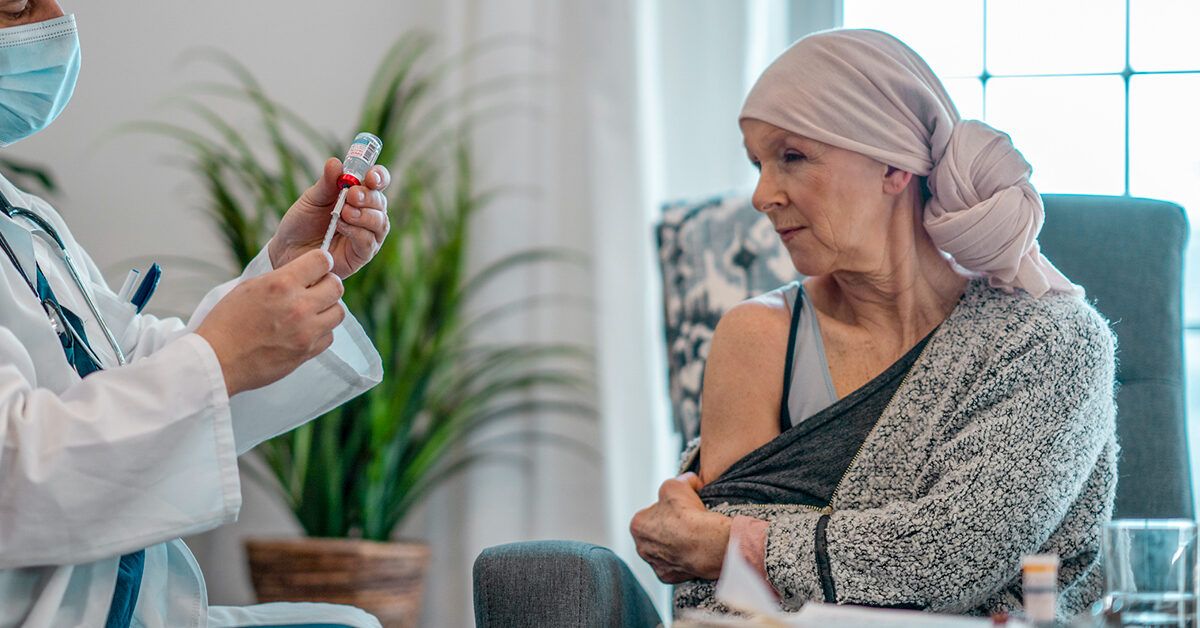
COVID vaccine multiple myeloma is a complex issue requiring careful consideration. Multiple myeloma, a cancer of the plasma cells in the bone marrow, presents unique challenges for patients, especially regarding their immune systems. Understanding the potential interactions between the COVID-19 vaccine and multiple myeloma treatment is crucial for informed decision-making. This exploration delves into the specifics of both conditions, examining their mechanisms, potential links, and impact on treatment approaches.
This discussion will cover the science behind both COVID-19 vaccines and multiple myeloma, looking at how they work, their efficacy, and side effects. We’ll also examine the current scientific understanding of any potential link between vaccination and myeloma progression, including relevant studies and limitations. Finally, we’ll discuss the implications for patient care, treatment strategies, and public health considerations, concluding with advice for patients and healthcare providers.
Overview of Multiple Myeloma

Multiple myeloma is a cancer of the plasma cells, a type of white blood cell. It develops when these cells grow uncontrollably in the bone marrow, producing abnormal proteins that can damage the bones and impair the immune system’s ability to fight infections. This uncontrolled growth often leads to a variety of symptoms, impacting patients’ quality of life significantly.
Characteristics of Multiple Myeloma
Multiple myeloma is characterized by the presence of malignant plasma cells in the bone marrow, which infiltrate and damage the bone structure. These abnormal cells produce excessive amounts of monoclonal immunoglobulin, a type of antibody. This accumulation of abnormal proteins disrupts the normal function of the bone marrow, hindering the production of healthy blood cells.
Symptoms of Multiple Myeloma
The symptoms of multiple myeloma can vary greatly from person to person and often develop gradually. Common symptoms include bone pain, particularly in the back, ribs, and hips, as well as fatigue, frequent infections, and unexplained weight loss. Other symptoms can include excessive thirst and urination, and neurological problems. These symptoms may appear gradually or abruptly and vary in severity.
Stages of Multiple Myeloma
Multiple myeloma is often staged based on the International Staging System (ISS). The ISS categorizes patients into three stages (I, II, and III) based on their blood tests and clinical factors. Stage I generally indicates a better prognosis than Stage III.
Diagnostic Procedures for Multiple Myeloma
Diagnosis typically involves a combination of tests. A physical examination, along with blood tests to evaluate blood cell counts and the presence of abnormal proteins (monoclonal immunoglobulin), are initial steps. Bone marrow biopsies are crucial for confirming the diagnosis and determining the extent of the disease. Imaging studies, such as X-rays and CT scans, can identify bone lesions.
Treatment Approaches for Multiple Myeloma
Treatment for multiple myeloma depends on the stage of the disease, the patient’s overall health, and other factors. Common treatment approaches include chemotherapy, targeted therapies, and stem cell transplantation. Clinical trials may also be an option. The choice of treatment is individualized, taking into account patient preferences and potential side effects.
Impact of Multiple Myeloma on Patients’ Lives
Multiple myeloma significantly impacts patients’ lives, affecting their physical, emotional, and social well-being. The disease can cause pain, fatigue, and other debilitating symptoms. The emotional toll can be substantial, impacting mental health and relationships. The need for frequent medical appointments and treatments can also lead to social isolation. The disease and its treatments can also impact employment and financial stability.
Table: Stages, Symptoms, Treatments, and Prognosis of Multiple Myeloma
| Disease Stage | Symptoms | Treatment Options | Prognosis |
|---|---|---|---|
| Stage I | Bone pain, fatigue, frequent infections, weight loss | Chemotherapy, targeted therapy, and sometimes stem cell transplantation | Generally better than Stage III; treatment effectiveness varies significantly based on patient response and individual factors. |
| Stage II | Bone pain, fatigue, frequent infections, weight loss, increased thirst and urination | Combination therapies, chemotherapy, targeted therapy, stem cell transplantation | Treatment response and prognosis depend on individual factors and treatment adherence. |
| Stage III | Severe bone pain, significant fatigue, frequent infections, weight loss, neurological symptoms, and complications from bone lesions | Chemotherapy, targeted therapy, and often stem cell transplantation; treatment effectiveness and response vary. | Generally less favorable than Stage I or II; treatment options and outcomes are variable. |
The COVID-19 Vaccine: Covid Vaccine Multiple Myeloma
Understanding how COVID-19 vaccines work is crucial for making informed decisions about vaccination. These vaccines are designed to stimulate the body’s immune system to recognize and fight the virus without causing the disease. This approach, while not entirely novel, has proven remarkably effective in protecting individuals from severe illness.COVID-19 vaccines work by introducing either a weakened or inactive form of the virus, or just pieces of the virus, to the body.
This exposure triggers an immune response, including the production of antibodies and memory cells. These antibodies and memory cells “remember” the virus, allowing the immune system to respond more quickly and effectively if the body encounters the actual virus in the future. This process essentially prepares the body for a potential infection, offering protection from severe disease.
Mechanism of Action
Vaccines use different approaches to stimulate an immune response. mRNA vaccines, for example, introduce messenger RNA (mRNA) that instructs cells to produce viral proteins. These proteins are then recognized by the immune system, initiating an antibody response. Other vaccines use inactivated or weakened forms of the virus itself, or just specific viral components, such as spike proteins, to trigger an immune response.
Types of COVID-19 Vaccines
Several different types of COVID-19 vaccines have been developed and deployed globally. These include mRNA vaccines, viral vector vaccines, and inactivated vaccines. Each type has its own characteristics, efficacy, and safety profile.
Efficacy and Safety Profiles
The efficacy of COVID-19 vaccines has been rigorously tested in clinical trials and demonstrated through real-world data. mRNA vaccines, such as those from Pfizer-BioNTech and Moderna, have shown high efficacy in preventing severe illness, hospitalization, and death. Viral vector vaccines, like those from AstraZeneca and Johnson & Johnson, also demonstrate significant efficacy. The safety profiles of these vaccines are generally good, with mild side effects being the most common.
Extensive monitoring and surveillance have consistently shown that these vaccines are safe and effective.
Recent studies on the connection between COVID vaccines and multiple myeloma in middle-aged Americans are raising some serious questions. While the link between the vaccine and the disease is still being investigated, the overall health of middle-aged Americans is concerning, with many facing a decline in physical and mental well-being compared to previous generations. This is further complicated by the potential long-term effects of the COVID vaccines, adding another layer of complexity to the issue.
Understanding the factors contributing to this trend, including the potential interplay between lifestyle, pre-existing conditions, and vaccination, is crucial to further research on the long-term effects of the COVID vaccine on multiple myeloma. For more on the health disparities facing middle-aged Americans, check out this article: middle aged americans worse shape than previous generations.
Potential Side Effects
Common side effects associated with COVID-19 vaccination include pain at the injection site, fatigue, muscle aches, headache, and fever. These side effects are typically mild and resolve within a few days. Serious side effects are rare, but some individuals may experience allergic reactions. It’s important to note that the risk of severe side effects is significantly lower than the risk of severe COVID-19 infection.
Long-Term Effects
The long-term effects of COVID-19 vaccination are still under investigation. Early data suggest that these vaccines are safe and do not appear to cause long-term health problems. However, ongoing research continues to monitor the impact of vaccination on various aspects of health over extended periods.
Vaccine Types, Efficacy, and Potential Side Effects
| Vaccine Type | Efficacy Rate (approximate) | Potential Side Effects |
|---|---|---|
| mRNA (Pfizer-BioNTech, Moderna) | >90% | Pain at injection site, fatigue, muscle aches, headache, fever, rarely allergic reactions |
| Viral Vector (AstraZeneca, Johnson & Johnson) | >70% | Pain at injection site, fatigue, muscle aches, headache, fever, rarely allergic reactions |
| Inactivated (Sinovac, Sinopharm) | Varying efficacy rates | Pain at injection site, fatigue, muscle aches, headache, fever, rarely allergic reactions |
The Potential Link Between COVID-19 Vaccination and Multiple Myeloma
The COVID-19 pandemic spurred a global effort to develop and deploy vaccines. While these vaccines have demonstrably reduced severe illness and death, the long-term effects of these vaccines on various health conditions are still being studied. One area of concern is the potential link between COVID-19 vaccination and the development or progression of multiple myeloma, a cancer of the plasma cells.
This exploration delves into the current scientific understanding of this potential connection.The existing research on the link between COVID-19 vaccination and multiple myeloma is still preliminary. While no conclusive evidence supports a direct causal relationship, ongoing investigations aim to identify potential associations and mechanisms. Researchers are actively scrutinizing epidemiological data and biological pathways to determine if any correlation exists.
Current Scientific Understanding
The scientific community is actively studying potential links, but conclusive evidence of a causal relationship between COVID-19 vaccination and multiple myeloma is lacking. Observational studies and clinical trials are ongoing to assess the incidence of multiple myeloma in vaccinated versus unvaccinated populations.
Observed Correlations and Potential Mechanisms
Some studies have examined potential correlations, but it’s crucial to remember that correlation does not equal causation. Researchers are exploring potential mechanisms, such as the impact of the immune response to the vaccine on existing myeloma cells or the potential for inflammation to play a role. However, there is currently no established mechanism linking COVID-19 vaccines to myeloma development.
Results of Relevant Studies and Research
Numerous ongoing studies are investigating the potential connection. Published data is often preliminary and focused on initial observations. Larger, more comprehensive studies are needed to establish a more definitive picture. Unfortunately, a definitive, large-scale study examining the precise correlation is yet to be completed, and the results of ongoing studies are not yet publicly available in a conclusive manner.
Limitations of Existing Research
The current research on this topic faces several limitations. Study sizes are often small, follow-up periods are relatively short, and there may be confounding factors influencing the results. Moreover, the precise definition and classification of multiple myeloma can vary, potentially impacting the accuracy of the observed correlations. The lack of a standardized approach across different studies presents a further challenge in analyzing the results.
Comparison of Multiple Myeloma Incidence in Vaccinated and Unvaccinated Populations
| Population | Incidence Rate (Estimated) | Notes |
|---|---|---|
| Vaccinated | Unknown | Data from large-scale studies are not yet available. |
| Unvaccinated | Unknown | Data from large-scale studies are not yet available. |
Note: The table presents an estimated comparison of incidence rates. The lack of conclusive data prevents precise estimates. More comprehensive studies are needed to accurately measure and compare the incidence rates between vaccinated and unvaccinated populations.
Impact on Treatment and Management
Understanding the potential impact of COVID-19 vaccination on multiple myeloma treatment is crucial for optimizing patient care. While the exact mechanisms are still being explored, early research suggests vaccination status might influence treatment response and overall outcomes. This section delves into the potential interplay between vaccination and various myeloma therapies, offering insights for healthcare professionals and patients.
Potential Impact of Vaccination on Treatment Approaches
Multiple myeloma treatment encompasses a range of approaches, including chemotherapy, targeted therapies, and immunomodulatory drugs. The impact of vaccination status on the effectiveness of these therapies is a subject of ongoing investigation. Early observations indicate that vaccination status might influence the immune response to myeloma treatments, potentially affecting the efficacy and safety profiles of different regimens.
Efficacy of Treatment Modalities in Vaccinated and Unvaccinated Patients
A comprehensive comparison of treatment outcomes in vaccinated and unvaccinated multiple myeloma patients is not yet available. However, studies are underway to investigate the potential differences in response rates and progression-free survival between these groups. The results of these studies will be vital in informing treatment strategies and optimizing patient care.
Influence of Vaccination Status on Response to Therapy
The immune system plays a significant role in the treatment of multiple myeloma. Vaccination, by boosting the immune response, might either enhance or diminish the effectiveness of therapies. For example, certain immunomodulatory drugs work by stimulating the immune system. A vaccinated patient might experience a more robust response to these therapies compared to an unvaccinated patient. Conversely, the presence of pre-existing antibodies from vaccination might potentially interfere with the effectiveness of certain therapies.
More research is necessary to fully understand the intricate relationship between vaccination status and therapeutic responses.
Precautions and Considerations for Healthcare Providers, Covid vaccine multiple myeloma
Healthcare providers should consider a patient’s vaccination status when developing a treatment plan. This includes acknowledging the potential impact on the patient’s immune response and tailoring the treatment regimen accordingly. It is essential to carefully monitor patients for any adverse reactions or complications that might be related to both the vaccination and the treatment. Open communication between the healthcare team and the patient is crucial for managing expectations and mitigating potential risks.
Table: Potential Impact of Vaccination Status on Treatment Modalities
| Treatment Modality | Potential Impact in Vaccinated Patients | Potential Impact in Unvaccinated Patients | Further Research Needed |
|---|---|---|---|
| Chemotherapy | Potentially enhanced immune response to some chemotherapeutic agents, but also possible interference with certain drug mechanisms. | Standard efficacy expected, with potential variations based on individual immune responses. | Studies on specific chemotherapeutic regimens and their interaction with vaccination status. |
| Targeted Therapies | Possible modulation of the effectiveness of targeted therapies based on the presence of vaccine-induced antibodies. | Expected efficacy based on established mechanisms of action. | Detailed analyses of specific targeted therapies and their potential interaction with vaccine-induced immune responses. |
| Immunomodulatory Drugs (IMiDs) | Potentially enhanced efficacy due to synergistic immune stimulation. | Standard efficacy anticipated. | Longitudinal studies to assess the interaction of IMiDs with vaccination status on disease progression. |
Public Health Implications
Navigating the potential link between COVID-19 vaccination and multiple myeloma necessitates a cautious and comprehensive approach. Misinformation and speculation can undermine public trust in both vaccines and cancer treatments. Therefore, accurate information dissemination is crucial for maintaining public health strategies and fostering informed decision-making.The impact of this potential link extends beyond individual patient care. Public health strategies surrounding both COVID-19 vaccination and multiple myeloma management may require adjustments.
While the COVID vaccine’s impact on multiple myeloma is still being studied, it’s crucial to remember that robust food safety protocols, like those enforced through food safety government inspection , are equally vital. Proper oversight and adherence to regulations are key to preventing illness and ensuring the safety of our food supply, and that translates directly back to the need for ongoing research into the long-term effects of the COVID vaccine on various health conditions like multiple myeloma.
This includes ensuring equitable access to vaccination, promoting informed choices, and adapting surveillance systems to detect any potential correlations.
Importance of Accurate Information Dissemination
The spread of accurate information about the potential link between COVID-19 vaccination and multiple myeloma is paramount. This involves clear, evidence-based communication to the public and healthcare professionals alike. Reliable sources, such as reputable medical organizations and scientific publications, should be emphasized. Misinformation campaigns can lead to vaccine hesitancy, impacting herd immunity and potentially exposing vulnerable populations to the virus.
This can also discourage patients with multiple myeloma from receiving necessary vaccinations, further complicating their treatment and management. Moreover, accurate information will allow individuals to make informed decisions about their health, and healthcare professionals can better counsel their patients.
Navigating the complexities of COVID vaccine side effects, especially in relation to multiple myeloma, can be tough. But did you know that decluttering, like Marie Kondo’s method, can actually boost your well-being and save money? Learning to appreciate and only keep items that “spark joy” can create a calmer and more organized space, which, in turn, can be incredibly helpful in managing the emotional toll of a health condition like multiple myeloma.
Check out this article to learn more about how tidying up like Marie Kondo is good for your health and your wallet why tidying up like marie kondo is good for your health and your wallet to better manage the emotional aspects of your health journey. Ultimately, finding effective coping mechanisms, whether through decluttering or other means, can significantly support your overall recovery from multiple myeloma.
Potential Impact on Public Health Strategies
The potential link necessitates a re-evaluation of current public health strategies for both COVID-19 vaccination and multiple myeloma management. For COVID-19 vaccination, this might involve tailored messaging to specific demographics, especially those with pre-existing conditions or concerns about the link to myeloma. For multiple myeloma management, it could mean revisiting vaccination recommendations and protocols, considering the potential interactions between vaccines and treatments.
Need for Further Research
The observed potential correlations between COVID-19 vaccination and multiple myeloma warrant further research. Observational studies and rigorous clinical trials are needed to determine the causal relationship, if any. This research should focus on identifying potential mechanisms of interaction and exploring the long-term effects of vaccination on myeloma development and progression. This proactive research will provide more definitive answers to questions regarding any observed correlation and help guide future public health strategies.
It is important to recognize that establishing causality requires meticulous design and execution of research studies.
Summary of Public Health Implications and Necessary Actions
| Public Health Implications | Necessary Actions |
|---|---|
| Accurate information dissemination regarding potential link between COVID-19 vaccination and multiple myeloma | Collaborate with reputable organizations and experts to develop and disseminate accurate information. |
| Potential impact on public health strategies for COVID-19 vaccination and myeloma management | Adjust strategies to account for potential interactions and concerns. |
| Need for further research to clarify any observed correlations | Conduct well-designed observational studies and clinical trials to investigate potential causality. |
Patient Considerations and Advice

Navigating the complexities of COVID-19 vaccination while managing multiple myeloma requires careful consideration. This section offers practical advice and insights, emphasizing the importance of open communication and providing resources for patients to make informed decisions. Understanding the potential benefits and risks, coupled with a clear understanding of your specific situation, is paramount.This advice is not a substitute for professional medical guidance.
Always consult with your healthcare team to discuss your individual circumstances and develop a personalized vaccination plan.
Understanding the Potential Benefits of Vaccination
The COVID-19 vaccines have proven remarkably effective in preventing severe illness and hospitalization. For myeloma patients, this translates to reduced risk of complications from infection, which can be particularly significant given the potential impact on treatment regimens and overall health. This is especially important for those with weakened immune systems. Studies have shown that vaccination can offer substantial protection against severe COVID-19, even in individuals with weakened immune systems.
Understanding the Potential Risks of Vaccination
While the benefits generally outweigh the risks, it’s essential to be aware of potential side effects. These might include mild symptoms like fever, fatigue, or soreness at the injection site. For myeloma patients, any potential reaction should be carefully monitored and discussed with a doctor. Rarely, more severe reactions can occur. It is crucial to prioritize open communication with your healthcare team to address any concerns.
Open Communication with Healthcare Providers
Open and honest dialogue with your healthcare team is vital. Discuss your medical history, current treatment, and any concerns you have regarding the COVID-19 vaccine. Your doctor can provide personalized guidance, assess potential risks, and address any questions you may have. This proactive approach ensures that the vaccination decision aligns with your individual needs and treatment plan.
Resources for Additional Information
Numerous resources can provide additional information on COVID-19 vaccination for myeloma patients. Consult your doctor for personalized recommendations. Reliable sources like the CDC (Centers for Disease Control and Prevention) and the National Cancer Institute (NCI) offer valuable information on the safety and efficacy of COVID-19 vaccines.
Questions to Ask Your Doctor
| Question | Explanation |
|---|---|
| What are the potential benefits of COVID-19 vaccination for me, considering my myeloma diagnosis and treatment? | This directly addresses the impact of the vaccine on your specific health situation. |
| What are the potential risks of COVID-19 vaccination for me, considering my myeloma diagnosis and treatment? | Understanding potential side effects and how they might interact with your myeloma treatment is crucial. |
| Are there any specific precautions or modifications to my vaccination schedule based on my current myeloma treatment? | This addresses the potential need for adjustments in timing or type of vaccine. |
| What are the recommended steps for managing any potential side effects from the COVID-19 vaccine? | Having a plan in place for managing side effects is essential. |
| How does COVID-19 vaccination interact with my current myeloma treatment plan? | This addresses potential interactions between the vaccine and ongoing treatment. |
| Are there any specific resources or support groups for myeloma patients regarding COVID-19 vaccination? | Access to resources and support can help address concerns and provide reassurance. |
Final Review
In conclusion, the interplay between COVID-19 vaccination and multiple myeloma is a significant area of research. While the current understanding of a direct link remains limited, the potential impact on treatment and patient outcomes necessitates careful consideration. Further research is crucial to fully understand this complex relationship and refine best practices for both conditions. Ultimately, open communication between patients and healthcare providers is paramount to navigating these considerations and ensuring optimal health outcomes.





